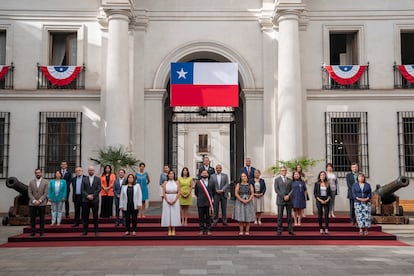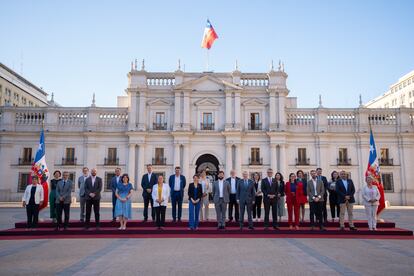Chile’s feminist Cabinet loses its parity for the first time
President Gabriel Boric had made maintaining a gender balance a key priority but there are now 13 male and 11 female ministers, three fewer than when he took office


When the leftist Gabriel Boric took office as Chile’s president on March 11, 2022 and swore in his Cabinet, which contained 14 female ministers and 10 males, he said: “I am deeply proud that there are more women than men. And that is thanks to the feminist movement.” At that time, not only did his core team contain more women than men, but his administration also marked a milestone by appointing a female Minister of the Interior and Public Security for the first time in the country’s history, the physician Izkia Siches.
A little over a year later the Interior and Public Security portfolio, one of the most important government positions in Chile, remains in the hands of a female minister, Carolina Tohá. But the appointment of socialist Álvaro Elizalde as Minister of General Secretariat of Government (Segpres) on April 19 ― replacing the lawyer Ana Lya Uriarte, who stepped down for health reasons ― ended the parity in the heart of Boric’s government, which for the first time during his presidency now comprises more men than women: 13 to 11.
Boric has so far made two changes within his government and in both he attempted to safeguard the gender parity that has been a hallmark of his administration. The first shuffle came after the referendum of September 2022, in which 62% of Chileans rejected a proposal to enshrine a new Constitution. That was when Siches ― a member of Boric’s inner circle ― left and Tohá entered. He also switched the portfolio of Giorgio Jackson, his closest adviser, from Segpres to Social Development. In his place he appointed Uriarte, which led to a clear female-majority cabinet with 15 women ministers to nine men.
The second change took place on March 10, a day before Boric’s first anniversary as president. The new structure contained two fewer women than when the government was sworn in, but it remained egalitarian: 12 women and 12 men. However, as part of this decision Foreign Minister Antonia Urrejola, who held a key portfolio with international visibility, was replaced by Alberto van Klaveren.


But after the arrival of Elizalde, who left the Senate to join the Cabinet, the predominance of women over men in the early days of Boric’s government was lost. According to María de los Ángeles Fernández, a political scientist and president of Hay Mujeres, a foundation that promotes visibility and leadership among women, Boric, by installing parity as a principle and a mechanism to form his government, “made the same mistake as Michelle Bachelet in her first term (2006-2010).” In Fernández’s opinion, the former socialist president and the country’s only female leader, “inaugurated ministerial parity in Chile in 2006 based on mathematical criteria, but could not keep her promise since it was altered in successive Cabinet changes.”
Fernández explains that both the Bachelet and Boric administrations “have lacked ― from the point of view of governmental communication ― a narrative on the meaning of parity, in the sense that it is not necessarily a matter of clinging to a rigid mathematical figure, but rather the desire for a balanced relationship between 60% and 40% representation of each sex. This is what is meant by flexible parity.”
Jorge Navarrete, a lawyer and political columnist, tells EL PAÍS that, more than the numbers, what has been lost alongside parity in the Boric government is symbolism. “In general, this government has at times been, and still is, somewhat grandiloquent on certain positions. It was the case with the environmentalist and ecological government, and the parity government. Therefore, any falls, even if they are not particularly significant, are very noticeable when they come from very high up. It conspired that President Boric’s first Cabinet changes affected more women than men.”
Still, the analyst points out, when the numbers are taken into consideration, it is undeniable that there is still a very important female presence among Boric’s team. “However, far from the expectations that the government had sown, the recent departure of Minister Ana Lya Uriarte marks a certain tendency that in the most relevant ministries, despite the government’s declarations and calling, women end up being more affected than men.”
Navarrete also points to another factor: cultural changes, which take time: “Chilean politics is still preferentially dominated not only by men, but by a male code. As such, when the time comes to turn to a certain contingent cast to replace positions within the same category, there is always a greater available stock of men than of women.” Even in the first Chilean government to declare itself openly feminist.
Sign up for our weekly newsletter to get more English-language news coverage from EL PAÍS USA Edition
Tu suscripción se está usando en otro dispositivo
¿Quieres añadir otro usuario a tu suscripción?
Si continúas leyendo en este dispositivo, no se podrá leer en el otro.
FlechaTu suscripción se está usando en otro dispositivo y solo puedes acceder a EL PAÍS desde un dispositivo a la vez.
Si quieres compartir tu cuenta, cambia tu suscripción a la modalidad Premium, así podrás añadir otro usuario. Cada uno accederá con su propia cuenta de email, lo que os permitirá personalizar vuestra experiencia en EL PAÍS.
¿Tienes una suscripción de empresa? Accede aquí para contratar más cuentas.
En el caso de no saber quién está usando tu cuenta, te recomendamos cambiar tu contraseña aquí.
Si decides continuar compartiendo tu cuenta, este mensaje se mostrará en tu dispositivo y en el de la otra persona que está usando tu cuenta de forma indefinida, afectando a tu experiencia de lectura. Puedes consultar aquí los términos y condiciones de la suscripción digital.
More information

Why Chile is home to the fastest trains in South America

Renewable energy boom in Chile takes a toll on electrical grid
Archived In
Últimas noticias
There is as much life left to discover on planet Earth as that which is already known
Dozens presumed dead, around 100 injured in fire at Swiss Alps bar during New Year’s celebration
Is porn for women different from conventional porn? We spoke to those who make it
Cartagena de Indias is sinking: What can the city do to mitigate it?
Most viewed
- David King, chemist: ‘There are scientists studying how to cool the planet; nobody should stop these experiments from happening’
- Reinhard Genzel, Nobel laureate in physics: ‘One-minute videos will never give you the truth’
- Oona Chaplin: ‘I told James Cameron that I was living in a treehouse and starting a permaculture project with a friend’
- Sinaloa Cartel war is taking its toll on Los Chapitos
- The Interoceanic Train, the Mexican alternative to the Panama Canal








































